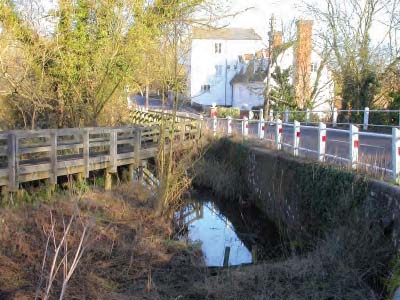|
There are relatively few species of land or freshwater molluscs on the British list which have their type localities in Britain. Those that are include species described by Alder, da Costa, Montagu, Jenyns and so on. Thus a site which is the type locality for 2 species is most unusual. In 1823 the Reverend Revett Sheppard described Turbo leachii based on specimens sent to him by Dr Leach. The species was recorded as “found sparingly in Campsey Mere, and Holbrook stream and millpond. In the same paper (Sheppard 1823) he also described Tellina henslowana based upon specimens collected by Professor Henslow from an unknown location and again sent to him by Leach. Sheppard notes that the species was found “sparingly in the stream at Holbrook”. These species are now known as Bithynia leachii and Pisidium henslowanum and Holbrook millpond and stream in Suffolk is accepted as the type locality for both. The following is taken from Killeen (1992): The Rev. Revett Sheppard (1778-1830) made the first major contribution to the knowledge of the mollusc fauna of Suffolk. He was born at Campsey Ash, and was educated at Ipswich and Cambridge before ordination as a priest in 1805. He was curate of Wrabness, Essex (where he died), perpetual curate of Willisham (1809-30), and Rector of Thwaite (1825-30). There are no clues as to the origin of Sheppard’s interest in molluscs, although it may well have been stimulated by the Rev. William Kirby (1759-1851), the famous entomologist and naturalist and Rector of Barham, whom Sheppard held as a revered friend. Sheppard published two works on molluscs in the Transactions of the Linnean Society. The first was on ‘British Species of Mytilus’ (Sheppard, 1822), in which he described forms of Anodonta living at Barham and Campsey Ash. The second (Sheppard, 1823) gives a catalogue of seventy species, thirty- six of which are described in detail in Latin along with habitat and locality data. Sheppard’s collection was purchased by Philip Brookes Mason of Burton-on-Trent. This now forms part of the A. S. Kennard collection, which is housed in the British Museum (Natural History). However, the type material of Bithynia leachii and Pisidium henslowanum is no longer present (M. P. Kerney pers. comm.). Michael Kerney visited Holbrook millpond in 1970 and recorded 24 species of freshwater molluscs including Bithynia leachii and Pisidium henslowanum (Kerney 1971). I also visited the site during the 1980s as part of the Suffolk mollusc Atlas project and again recorded both species (Killeen 1992). In early 2007 I had reason to revisit Holbrook millpond when Peter Glöer asked if I could collect him some topotypic material of Bithynia leachii. The village of Holbrook lies on the peninsula formed by the estuaries of the River Stour and River Orwell, c. 8km south of Ipswich. The pond is c. 300m long and most is surrounded by woodland. The outlet stream to the mill passes under a road at the eastern end of the pond. There has some recent felling to create more open areas for angling. Patches of Glyceria maxima, Phragmites australis and Sparganium erectum are sparsely distributed around the margins. The substrate is mostly mud, dead vegetation and detritus. There was little evidence of other aquatic macrophytes at the time of the visit. Subsequent to my visit some parts of the pond were dredged (Adrian Chalkley pers comm. ). Bithynia leachii was found to be extremely common and although the most of the specimens appeared to be adult, the shell height was rarely more than 5mm. Many of the shells were corroded and pitted. Pisidium henslowanum was also present but in very low numbers (Kerney 1971 recorded it in ‘fair numbers’). The other molluscs found were much the same as recorded by Kerney and by myself in the 1980s with the exception of Radix auricularia and unionid mussels which were not searched for (although they were subsequently recorded by Adrian Chalkley from dredge spoil). The fauna included Pisidium hibernicum which is uncommon in the county but is particularly unusual in ponds (in Suffolk). However, on this occasion an additional species, the limpet Ferrissia wautieri (=Ferrissia clessiniana) was recorded. Ferrissia wautieri was previously unknown in Suffolk but I was subsequently contacted by Adrain Chalkely, one of the county’s recorders, who sent me photographs of Ferrissia collected from a farm pond at Elmsett (c. 13km west of Holbrook) in 2006. Adrian also recorded the species from four ponds at Center Parcs Holiday village at Elvedon, in the north-west of the county in late 2007. I had carried out surveys there in the 1980s and Adrian has also been surveying there for a number of years. Thus Ferrissia is clearly a recent arrival at these sites rather than having gone un-noticed. This suggests that recorders should continue to look out for this species along with others that may go overlooked. A good example is the planorbid Menetus dilatatus which I have seen specimens of from 3 southern England locations over the last 2 years. I thank Adrian Chalkley for kindly providing information on his Suffolk records and also for going to Holbrook and taking the photographs for me (after I had managed to lose mine from the computer!). ReferencesKerney, M.P., 1971. The type locality of Pisidium henslowanum (Sheppard). Conchologists’ Newsletter 36: 198-199. Killeen, I.J., 1992. The land and freshwater molluscs of Suffolk. Suffolk Naturalists' Society, Ipswich. Sheppard, R., 1822. On two new British species of Mytilus. Transactions of the Linnean Society of London 13: 83-87. Sheppard, R., 1823. Descriptions of seven new British land and freshwater shells, with observations on many other species, including a list of such as have been found in the county of Suffolk. Transactions of the Linnean Society of London 14: 148-170. |
|
Holbrook Millpond revisited
Issue
16
Page
9



 Holbrook Millpond and Mill (photos © Adrian Chalkely)
Holbrook Millpond and Mill (photos © Adrian Chalkely)